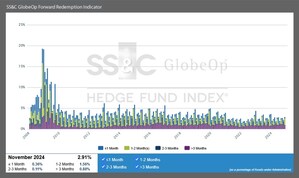WINDSOR, Conn., June 6, 2019 /PRNewswire/ -- SS&C Technologies Holdings, Inc. (Nasdaq: SSNC), today released the results of its Asset Manager Composite for the first quarter of 2019, which analyzes 181 publicly-traded firms. The results found that in Q1 2019, cumulative assets under management (AUM) rebounded by 8.5% to $12.942 trillion compared to $11.928 trillion in Q4 2019. This is just shy of the $12.961 trillion peak in Q3 2018.
"During Q1 2019, the U.S. equity markets bounced back from the turbulence we experienced in Q4," said Matthew Fronczke, Director, Strategic Business Consulting, SS&C Research, Analytics and Consulting. "As a result, AUM levels for the Composite group neatly recovered and are less than 1% shy of the Q3 2018 peak."
U.S. markets solidly bounce back in the first quarter
The S&P 500 Index rose by 13.7% during Q1, effectively reversing the 13.5% decline in Q4. Global equity markets also recovered with the MSCI EAFE Index returning 10.1% in Q1, compared to a 12.5% decline in Q4.
The Bureau of Economic Analysis (BEA) released their first read of Q1 2019 GDP reporting a 3.2% annual growth rate, compared to consensus estimates of well under 2.0%. Overall, 2019 economic growth expectations for the U.S. still remain moderate relative to 2018. After raising rates in December 2018 by 0.25%, the Federal Reserve seems to be content with current rates; with a broad consensus view that a rate cut may appear sometime in 2019.
Key performance metrics for Q1 2019
- Operating margins for the Composite group dropped by 153 basis points to 28.6% in Q1, versus 30.1% in Q4. This level represents the lowest operating margin for the Composite since Q3 2010.
- Four of the 18 firms in the Composite group experienced improving operating margins on a sequential basis. The remaining 14 firms saw their operating margins decline.
- Despite rising AUM for the Composite group at the end of Q1, asset-generated fee revenues declined by 0.8% sequentially, and drove down overall revenues (-1.3% sequentially). Overall revenues of $11.387 billion were modestly below the level achieved in Q2 2017. 15 of the 18 firms in the Composite group experienced sequentially declining revenues in Q1.
- Operating expenses for the asset management industry increased by 0.5% in Q1 compared with Q4, largely due to seasonal factors including annual bonus payouts, etc.
- The combined impact of a 1.3% decline in revenues with a 0.5% increase in expenses, reduced operating margins for the Composite group by 153 basis points, as noted earlier.
- The AUM rebound for the Composite group was broad-based in Q1 with all 18 firms in the group experiencing AUM increases.
- As markets recovered throughout Q1, investors seemed to respond by putting capital to work. Q1 saw net inflows of $37.6 billion compared to Q4 net outflows of $26.5 billion. 11 of the firms in the Composite group still experienced outflows in Q1, compared to 13 firms with outflows in Q4.
- All 17 firms (that report flows and market performance) experienced positive market performance during Q1. 96.2% of the sequential rebound in AUM from Q4 to Q1 can be attributed to market performance (with net flows attributing 3.8%). Essentially, it was all about market performance during the first quarter.
The accompanying chart (operating margin vs. net margin trend lines) shows a somewhat divergent story: continued moderation in operating margins, but an improvement in net margins during Q1 2019. Net margins had dropped more sharply in Q4 2018 compared to operating margins due to higher non-operating expenses. During Q1, non-operating expenses normalized, thus bringing net margins back on trend line.
About the Study
The SS&C Research, Analytics, and Consulting Group (formerly DST) helps organizations manage data, gain insight and ignite change. Since Q1 2009, the group has performed consolidated financial statement analysis using the public quarterly earnings of the following composite of 15 asset management firms3. Analysis each quarter includes an adjustment to operating margins to account for one-time charges. It does not, however, include adjustments for stock-based compensation and goodwill amortization as there are variances in reporting by individual asset management firms. Therefore, our operating margins at the individual firm level may differ materially from the "fully adjusted, non-GAAP" operating margins reported by company management. The adoption of Topic 606 – a new revenue recognition accounting principle – starting in Q1 2018 – has impacted at least ten of the firms comprising the Composite: thus, the income statement impact (and therefore, for operating margin analysis) can only be reflected back to Q1 2017 on a comparable basis.
Firms included in the SS&C Research, Analytics and Consulting Asset Manager Composite [firms in bold added in Q2 2018]: Affiliated Managers Group (AMG), Alliance Bernstein (AB), Artisan Partners (APAM), BlackRock (BLK), Cohen & Steers (CNS), Diamond Hill Investment Group (DHIL), Federated Investors (FII), Franklin Templeton (BEN), GAMCO (GBL), Invesco (IVZ), Janus Henderson Group (JHG), Legg Mason (LM), Manning & Napier (MN), Pzena Investment Management (PZN), SEI (SEIC), T. Rowe Price (TROW), Victory Capital (VCTR) and Waddell & Reed (WDR).
About SS&C Technologies
SS&C is a global provider of investment and financial software-enabled services and software for the global financial services and healthcare industries. Founded in 1986, SS&C is headquartered in Windsor, Connecticut and has offices around the world. Some 18,000 financial services and healthcare organizations, from the world's largest institutions to local firms, manage and account for their investments using SS&C's products and services.
Additional information about SS&C (Nasdaq: SSNC) is available at www.ssctech.com.
Follow SS&C on Twitter, LinkedIn and Facebook.
1 Starting with Q2 2018, three additional firms have been included in the Composite to include recently public firms and to be more comprehensive in our analysis. The additions are identified with the full list at the end of this press release. Historical Composite references have been updated to reflect these additions.
2 Operating margin (as further expounded in About the Study) is profitability after deducting operating expenses from revenues. Net margin is net income profitability, after taxes and non-operating items.
3 Three asset management firms financials were retroactively added in during Q2 2018. For these firms, the Composite data has been adjusted back to Q1 2017.
SOURCE SS&C

Related Links
WANT YOUR COMPANY'S NEWS FEATURED ON PRNEWSWIRE.COM?
Newsrooms &
Influencers
Digital Media
Outlets
Journalists
Opted In





Share this article